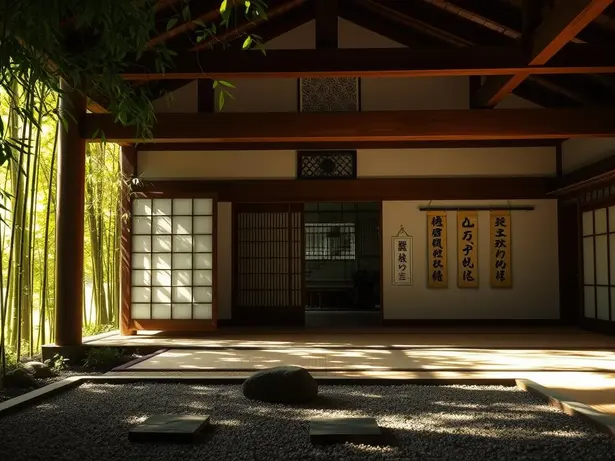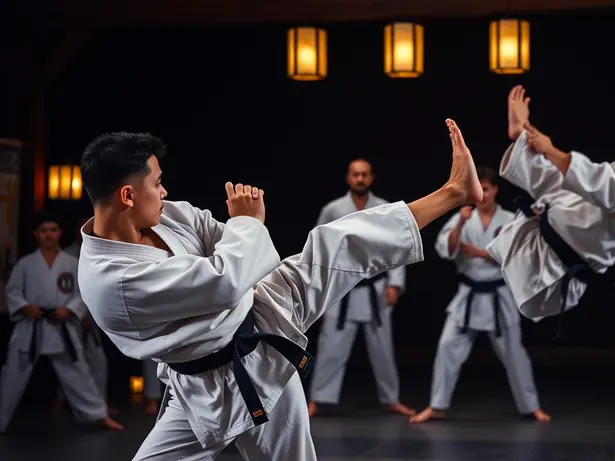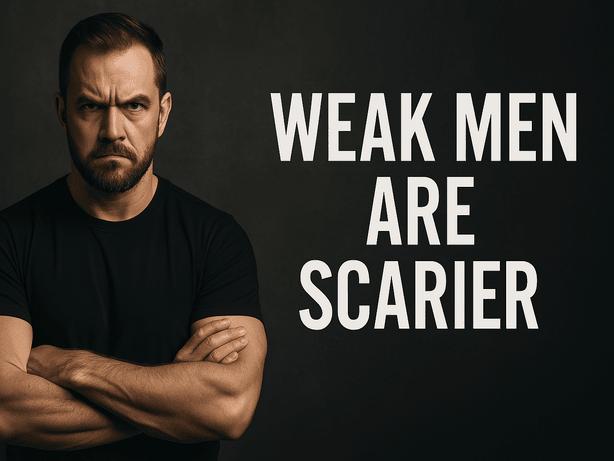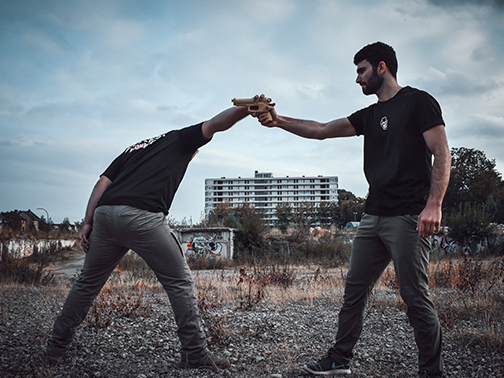What is the real meaning of dojo?

The word "dojo" comes from Japanese. It is deeply connected to martial arts philosophy. It means "place of the Way." If you're into karate martial arts, knowing about dojo is key.
At first, I thought a dojo was just a place to train. But it's more. It's where people come to learn and grow. They improve not just their bodies but also their minds.
The dojo's philosophy is about being disciplined, respectful, and always trying to get better.
To learn more about martial arts, check out https://fightmore.nl/martialarts. It has lots of info on different martial arts.
Key Takeaways
- The term "dojo" is derived from Japanese and means "place of the Way."
- A dojo is significant in karate martial arts as a place for holistic development.
- The philosophy of a dojo emphasizes discipline, respect, and self-improvement.
- Understanding the concept of a dojo enhances one's martial arts journey.
- A dojo is not just a physical training space but a mental and spiritual one as well.
The Origin and Definition of Dojo
To understand "dojo," we need to look at its roots. The word "dojo" comes from Japanese. "Do" means "way" and "jo" means "place" or "hall."
Etymology and Literal Translation
The word "dojo" is made of two Japanese characters. "Do" means "way" or "path." "Jo" means "place" or "hall."
At first, it was for Buddhist training and meditation. Later, it also meant halls for martial arts.
Historical Context in Japanese Culture
In Japan, the dojo has a deep history. It started in Buddhist monasteries and became places for martial arts.
This change shows how martial arts and spiritual practices came together.
Early Training Halls in Japan
Early dojos in Japan were linked to Buddhist temples. They were for martial arts and spiritual training.
The idea of a dojo as a martial arts place grew over time. It was shaped by Japan's culture and religion.
Some important things about early dojos are:
- They were tied to Buddhist temples.
- They were for martial arts and spiritual training.
- They evolved into places just for martial arts.
If you want to learn more about martial arts and their culture, check out FightMore.nl. It has lots of useful information.
The Philosophy Behind the Dojo Concept
Understanding the dojo concept means looking into its deep ideas. These ideas shape how people act and grow inside it. The dojo is more than a place; it's a space for deep thinking and spiritual growth.
More Than Just a Training Hall
A dojo is not just for martial arts. It's a place to learn about life's deeper truths. The way it's set up and the rituals help people learn discipline and respect.
The Concept of Community is key in the dojo. People train together, help each other, and grow together. This creates a strong bond among them.
Spiritual and Mental Aspects
The idea of "Do" or "The Way" is very important in the dojo. It's not just about physical training. It's about finding a path in life.
The Concept of "Do" (The Way)
The philosophy of "Do" shapes how people grow. It teaches a complete way of life. This includes physical skills, mental focus, and spiritual growth.
| Aspect | Description | Benefit |
| Physical | Techniques and forms (Kata) | Physical fitness and coordination |
| Mental | Focus, discipline, and mental toughness | Improved concentration and mental clarity |
| Spiritual | Connection to the philosophy of "Do" | Personal growth and self-awareness |
For more on martial arts and their deep ideas, check out FightMore.nl. It has lots of info on different martial arts.
Traditional Elements of a Karate Martial Arts Dojo
When I enter a traditional karate dojo, I feel a deep sense of history and discipline. This place is where karate meets culture and philosophy.
The dojo's layout is made to help everyone focus and show respect. It faces the Shomen, or front, with special symbols or images.
Physical Layout and Design
The dojo's design is more than pretty. It's made for training. It has a big, open space with a smooth floor, often wood, for all kinds of training.
Symbolic Features and Their Meanings
Important symbols in the dojo include the Shomen. It's the front and most honored spot. Here, you'll find pictures of the style's founder or important symbols.
Another key spot is the Joseki, at the dojo's top. It's where senior students or teachers sit.
Training Equipment and Tools
The dojo's tools are simple but useful. You'll find makiwara, punching bags, and gear for practicing forms (kata).
| Equipment | Purpose |
| Makiwara | Training tool for conditioning fists and feet |
| Punching Bags | For practicing striking techniques |
| Kata Equipment | Used in practicing pre-determined forms or patterns |
If you want to learn more about martial arts and traditional dojos, check out FightMore.nl. It has lots of useful info.
Etiquette and Protocols in the Dojo
Etiquette and protocols are key in the dojo. They help create a place of discipline and respect. These rules are not just about following them. They help everyone learn and grow together.
Bowing and Respect Rituals
Bowing shows respect and gratitude in the dojo. Practitioners bow when they enter or leave. The bow is a sign of humility and respect for the art's history.
One student said,
"Bowing is not just a physical act; it's a mental preparation for the training ahead."
Hierarchy and Rank System
The dojo has a strict hierarchy based on rank. Belts show how skilled a practitioner is. Knowing and respecting this hierarchy is important for a good training environment.
Higher-ranked students lead and help others. This builds a strong sense of community.
Behavioral Expectations During Training
During training, there are rules to follow. These include being on time, focused, and respectful. Keeping the dojo clean and organized is also important. It shows respect and discipline.
For more on martial arts and dojo culture, visit FightMore.nl.
In summary, dojo etiquette and protocols are vital for a good training experience. They promote respect, discipline, and teamwork. By following these rules, practitioners improve their skills and honor martial arts traditions.
The Role of Karate Martial Arts Training in a Dojo
The dojo is a special place. It's where karate training goes beyond just moving your body. It helps you grow in many ways.
Karate training in a dojo helps you get strong and focused. It teaches you to respect the art too.
Basic Techniques and Forms (Kata)
Karate starts with learning basic techniques. You learn stances, punches, and kicks. These are the basics.
Kata, or forms, are special patterns. They mix these basics into a flow. This helps you get better at balance and focus.
Sparring and Application (Kumite)
Kumite, or sparring, is fighting with an opponent. It's a key part of karate. It teaches you to react fast and think smart.
Sparring makes you better at using your skills. It improves your reflexes and timing.
Mental Development Through Physical Practice
Karate is not just for the body. It also helps your mind and heart. Learning karate teaches you to be strong and respectful.
As you get better, you learn more about yourself. You become more confident.
Karate training in a dojo is more than just fighting. It's about growing your mind and spirit too. For more on martial arts, check out FightMore.nl.
"The ultimate aim of karate lies not in victory or defeat, but in the perfection of the character of the participant."
This saying shows how karate is about more than winning. It's about becoming a better person.
The Sensei-Student Relationship in Traditional Dojos
A deep sense of respect and trust defines the sensei-student relationship in a traditional dojo. This bond is not just about martial arts techniques. It's about mentorship, guidance, and personal development.
The Role and Responsibilities of a Sensei
A sensei, or instructor, plays a multifaceted role. They do more than teach martial arts techniques. They create a supportive learning environment, foster discipline, and guide students both physically and mentally.
A sensei's responsibilities include:
- Teaching traditional martial arts techniques and forms
- Mentoring students in the philosophy and history of martial arts
- Encouraging personal growth and self-discipline
What it Means to Be a Student (Deshi)
Being a deshi, or student, in a traditional dojo is more than learning martial arts. It requires a commitment to the dojo hierarchy and a willingness to learn from one's sensei. Students are expected to show respect, dedication, and an openness to new challenges.
Building Trust and Respect
Building trust and respect between a sensei and their student is crucial. This is achieved through consistent training, open communication, and mutual respect. The table below outlines key aspects of this relationship:
| Aspect | Sensei's Role | Student's Role |
| Respect | Demonstrate respect through actions and words | Show respect through bowing, listening, and following instructions |
| Trust | Build trust by being consistent and fair | Build trust by being diligent and honest |
| Guidance | Provide clear guidance and feedback | Seek guidance and be receptive to feedback |
For more information on martial arts and the significance of the sensei-student relationship, visit FightMore.nl. This relationship is fundamental to the dojo culture. It's built on mutual respect, trust, and responsibility.
Finding the Right Dojo in the Netherlands
Finding a karate dojo in the Netherlands is more than just location. It's about the quality of teaching and the community. Look for a dojo that fits your martial arts needs.
What to Look for in a Quality Karate Dojo
A good karate dojo has experienced teachers. They give you personal feedback and help. Look for dojos with teachers from well-known martial arts groups.
The dojo's atmosphere and community are key. A supportive place helps you grow and stay motivated.
When you visit a dojo, watch a class. See how the teacher teaches and how students learn. Notice if the training fits your level. Talk to teachers and students to learn about the dojo's culture.
Popular Karate Styles and Schools in Dutch Communities
The Netherlands has many karate styles like Shotokan, Kyokushin, and Wado-Ryu. Each dojo might focus on a different style. Some might mix styles or add other martial arts.
Resources for Further Exploration
For more info, check out FightMore.nl. It has lots on martial arts in the Netherlands. You can find dojos, learn about styles, and meet other martial artists.
Research and visit different dojos. This way, you'll find a place that meets your needs and makes your martial arts journey better.
Conclusion: Embracing the True Spirit of the Dojo
A dojo is more than a place to learn martial arts. It's about the values and culture of karate. These are as important as the moves and forms.
Being part of a dojo means living by certain values. These include respect, discipline, and self-control. These values help us connect with the art and with each other.
If you're curious about martial arts, check out FightMore.nl. It has lots of info on karate and more. The dojo's spirit is about more than just training. It's about growing as a person every day.
FAQ
What is the meaning of "Do" in the context of a dojo?
"Do" means a path or way of life. It shows the spiritual and mental sides of martial arts, not just the physical.
What is the significance of bowing in a dojo?
Bowing shows respect, thanks, and understanding of the art and others. It's key in a traditional dojo.
How do I find a quality karate dojo?
Look for dojos with skilled teachers and a caring community. They should focus on both body and mind. FightMore.nl can help too.
What is the role of a sensei in a traditional dojo?
A sensei teaches and guides students in martial arts. They help with learning, correcting, and growing. They make the dojo a good place to train.
What are kata and kumite in karate training?
Kata are set forms that improve technique and focus. Kumite is sparring, using kata skills in a real way.
What should I expect during my first visit to a dojo?
You'll meet the sensei or a senior student first. They'll introduce you and show you around. Just watch, listen, and join in when you can.
Why is respect and discipline important in a dojo?
Respect and discipline make the dojo safe and helpful. They create a place where everyone respects each other and the art.
Can anyone join a karate dojo, regardless of age or experience?
Yes, most dojos welcome everyone, no matter age or skill. They often have classes for kids, adults, and beginners.
Ook iets voor jou?
Karate Martial Arts: The Basics
Unleash your inner warrior! 🌟 Discover the ancient art of karate from Okinawa, blending fitness and self-defense. What if mastering this discipline could change your life? 🥋✨

Think Tough Guys Are Scary? Wait Until You See What Weak Men Will Do…
Think you know strength? Discover why true power isn't just physical—it's about control and kindness. Are you ready to unleash your potential? Don’t miss out on this transformative journey!

What Are the Differences Between IKMF and KMG?
Deciding between IKMF and KMG for Krav Maga? Unlock the secrets to self-defense mastery! Discover their unique philosophies and find your perfect fit today!

Reacties (0)
Je moet inloggen om een reactie te kunnen plaatsen.
Nog geen reacties. Wees de eerste die reageert!